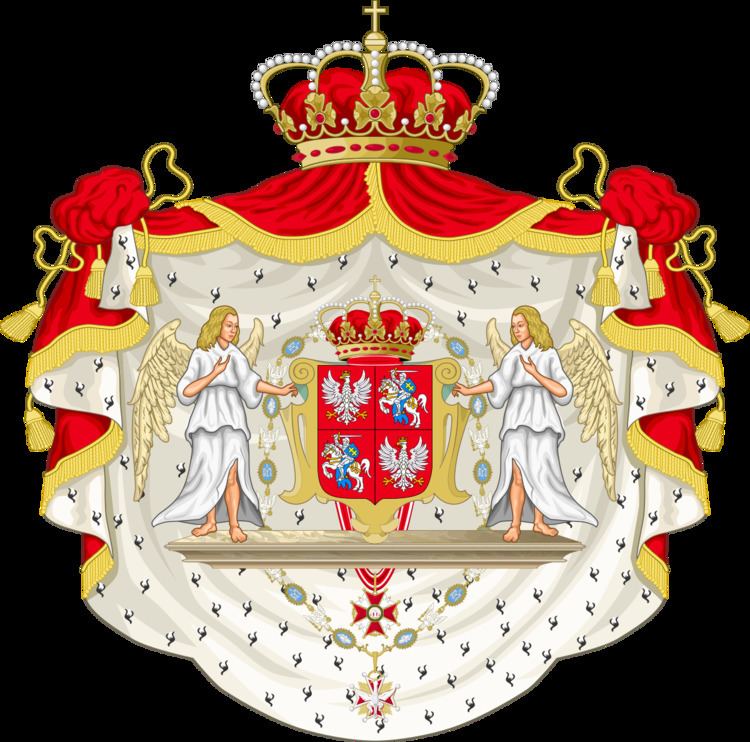First monarch Mieszko I Abolition 7 January 1795 | Last monarch Stanisław II Augustus | |
 | ||
Style Royal Majesty (HRM)
Wasza Królewska Mość
Serene Reigning Majesty
Jaśnie Panujący Mości
Grace (HG)
Wasza Miłość
Highness (HH)
Wasza Wysokość Formation ca. 960 (First Christian Monarch) Residence Wawel Castle
Warsaw Castle
Wilanów Palace | ||
Poland was ruled at various times either by dukes (the 9th–14th century) or by kings (the 11th-18th century). During the latter period, a tradition of free election of monarchs made it a uniquely electable position in Europe (16th–18th centuries).
Contents
- Poland in the Early Middle Ages
- Fragmentation of the Kingdom of Poland 11381314
- Reunification attempts in the Kingdom of Poland 12321305
- Pretenders to the Polish throne
- Not recognized royal elections
- References
The birth of Poland as an independent nation coincides with the ascension of Duke Mieszko I and adoption of Christianity under the authority of Rome in the year 966. He was succeeded by his son, Bolesław I the Brave, who greatly expanded the boundaries of the Polish state and ruled as the first king in 1025. The following centuries gave rise to the mighty Piast dynasty, consisting of both kings such as Mieszko II Lambert, Przemysł II or Władysław I the Elbow-high and dukes like Bolesław III Wrymouth. The dynasty ceased to exist with the death of Casimir III the Great in 1370. In the same year, the Capetian House of Anjou became the ruling house with Louis I as king of both Poland and Hungary. His daughter, Jadwiga, later married Jogaila, the pagan Grand Duke of Lithuania, who in 1386 was baptized and crowned as Władysław II Jagiełło, thus creating the Jagiellonian dynasty and a personal union between Poland and Lithuania.
During the reign of Casimir IV Jagiellon and Sigismund I the Old culture flourished and cities developed. This era of progress, also known as the Polish Renaissance, continued until the Union of Lublin under Sigismund II Augustus, which unofficially marked the end of the Polish Golden Age. After the death of last Jagiellonian king, the united Polish–Lithuanian Commonwealth became an elective monarchy with mostly foreigners elected as monarchs such as Henry III of France, who witnessed the introduction of Golden Liberty and Stephen Báthory, a great military commander who strengthened the nation. The meaningful rule of the Vasa dynasty initially expanded the Commonwealth, developing the arts and crafts, as well as trade and commerce. King Sigismund III Vasa, a talented but somewhat despotic ruler, involved the country in many wars, which subsequently resulted in the successful capture of Moscow and loss of Livonia to Sweden. His son, Władysław IV Vasa, fiercely defended the Commonwealth's borders and continued the policy of his father until death, unlike John II Casimir whose tragic rule forced his abdication.
The election of John III Sobieski to the Polish throne was a great success. His brilliant military tactics led to the victory at Vienna in 1683 and partial recapture of land from the Ottoman Empire. However, the years that followed weren't as successful; the long and ineffective rule of the Wettin dynasty (Augustus II the Strong and Augustus III) placed the Commonwealth under the influence of Saxony and the Russian Empire. Additional feud with rebelled nobility (szlachta) and most notably Stanisław I Leszczyński and France diminished the influence of Poland-Lithuania in the region. This led to the partitions that occurred under King Stanisław II Augustus, yet another enlightened, but ineffective monarch.
The last sovereign was Frederick Augustus I as Duke of Warsaw, who throughout his political career attempted at rehabilitating the Polish state. After Poland declared independence in 1918, the monarchy was abolished and a parliamentary republican authority was established.
Poland in the Early Middle Ages
See: Poland in the Early Middle Ages
Fragmentation of the Kingdom of Poland, 1138–1314
See also: Fragmentation of the realm and Testament of Bolesław III Wrymouth
